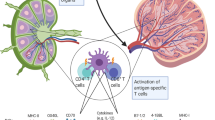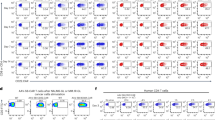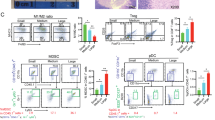Abstract
Recently, human dendritic cells (DCs) pulsed with mRNA encoding a broad range of tumor antigens have proven to be potent activators of a primary anti–tumor-specific T-cell response in vitro. The aim of this study was to improve the mRNA pulsing of murine DC. Compared to a standard lipofection protocol and passive pulsing, electroporation was, in our hands, the most efficient method. The optimal conditions to electroporate murine bone marrow–derived DCs with mRNA were determined using enhanced green fluorescent protein and a truncated form of the nerve growth factor receptor. We could obtain high transfection efficiencies around 70–80% with a mean fluorescence intensity of 100–200. A maximal expression level was reached 3 hours after electroporation. A clear dose–response effect was seen depending on the amount of mRNA used. Importantly, the electroporation process did not affect the viability nor the allostimulatory capacity or phenotype of the DC. To study the capacity of mRNA-electroporated DCs to present antigen in the context of MHC classes I and II, we made use of chimeric constructs of ovalbumin. The dose-dependent response effect and the duration of presentation were also determined. Together, these results demonstrate that mRNA electroporation is a useful method to generate genetically modified murine DC, which can be used for preclinical studies testing immunotherapeutic approaches.
This is a preview of subscription content, access via your institution
Access options
Subscribe to this journal
Receive 12 print issues and online access
$259.00 per year
only $21.58 per issue
Buy this article
- Purchase on Springer Link
- Instant access to full article PDF
Prices may be subject to local taxes which are calculated during checkout











Similar content being viewed by others
References
Steinman RM . The dendritic cell system and its role in immunogenicity Annu Rev Immunol 1991 9: 271–296
Banchereau J, Steinman RM . Dendritic cells and the control of immunity Nature 1998 392: 245–252
Thery C, Amigorena S . The cell biology of antigen presentation in dendritic cells Curr Opin Immunol 2001 13: 45–51
Fong L, Engleman EG . Dendritic cells in cancer immunotherapy Annu Rev Immunol 2000 18: 245–273
Dallal RM, Lotze MT . The dendritic cell and human cancer vaccines Curr Opin Immunol 2000 12: 583–588
Grabbe S, Beissert S, Schwarz T, Granstein RD . Dendritic cells as initiators of tumor immune responses: a possible strategy for tumor immunotherapy? Immunol Today 1995 16: 117–121
Palucka K, Banchereau J . Dendritic cells: a link between innate and adaptive immunity J Clin Immunol 1999 19: 12–25
Celluzzi CM, Mayordomo JI, Storkus WJ, Lotze MT, Falo LD Jr . Peptide-pulsed dendritic cells induce antigen-specific CTL-mediated protective tumor immunity J Exp Med 1996 183: 283–287
Porgador A, Snyder D, Gilboa E . Induction of antitumor immunity using bone marrow–generated dendritic cells J Immunol 1996 156: 2918–2926
Zitvogel L, Mayordomo JI, Tjandrawan T et al. Therapy of murine tumors with tumor peptide-pulsed dendritic cells: dependence on T cells, B7 costimulation, and T helper cell 1–associated cytokines J Exp Med 1996 183: 87–97
Nair SK, Boczkowski D, Snyder D, Gilboa E . Antigen-presenting cells pulsed with unfractionated tumor-derived peptides are potent tumor vaccines Eur J Immunol 1997 27: 589–597
Fields RC, Shimizu K, Mule JJ . Murine dendritic cells pulsed with whole tumor lysates mediate potent antitumor immune responses in vitro and in vivo Proc Natl Acad Sci USA 1998 95: 9482–9487
Lambert LA, Gibson GR, Maloney M, Barth RJ Jr . Equipotent generation of protective antitumor immunity by various methods of dendritic cell loading with whole cell tumor antigens J Immunother 2001 24: 232–236
Albert ML, Sauter B, Bhardwaj N . Dendritic cells acquire antigen from apoptotic cells and induce class I–restricted CTLs Nature 1998 392: 86–89
Paglia P, Chiodoni C, Rodolfo M, Colombo MP . Murine dendritic cells loaded in vitro with soluble protein prime cytotoxic T lymphocytes against tumor antigen in vivo J Exp Med 1996 183: 317–322
Inaba K, Metlay JP, Crowley MT, Steinman RM . Dendritic cells pulsed with protein antigens in vitro can prime antigen-specific, MHC-restricted T cells in situ J Exp Med 1990 172: 631–640
Hsu FJ, Benike C, Fagnoni F et al. Vaccination of patients with B-cell lymphoma using autologous antigen-pulsed dendritic cells Nat Med 1996 2: 52–58
Schnell S, Young JW, Houghton AN, Sadelain M . Retrovirally transduced mouse dendritic cells require CD4+ T cell help to elicit antitumor immunity: implications for the clinical use of dendritic cells J Immunol 2000 164: 1243–1250
De Veerman M, Heirman C, Van Meirvenne S et al. Retrovirally transduced bone marrow–derived dendritic cells require CD4+ T cell help to elicit protective and therapeutic antitumor immunity J Immunol 1999 162: 144–151
Specht JM, Wang G, Do MT et al. Dendritic cells retrovirally transduced with a model antigen gene are therapeutically effective against established pulmonary metastases J Exp Med 1997 186: 1213–1221
Song W, Tong Y, Carpenter H, Kong HL, Crystal RG . Persistent, antigen-specific, therapeutic antitumor immunity by dendritic cells genetically modified with an adenoviral vector to express a model tumor antigen Gene Ther 2000 7: 2080–2086
Kaplan JM, Yu Q, Piraino ST et al. Induction of antitumor immunity with dendritic cells transduced with adenovirus vector–encoding endogenous tumor–associated antigens J Immunol 1999 163: 699–707
Brossart P, Goldrath AW, Butz EA, Martin S, Bevan MJ . Virus-mediated delivery of antigenic epitopes into dendritic cells as a means to induce CTL J Immunol 1997 158: 3270–3276
Boon T, van der Bruggen P . Human tumor antigens recognized by T lymphocytes J Exp Med 1996 183: 725–729
Boczkowski D, Nair SK, Nam JH, Lyerly HK, Gilboa E . Induction of tumor immunity and cytotoxic T lymphocyte responses using dendritic cells transfected with messenger RNA amplified from tumor cells Cancer Res 2000 60: 1028–1034
Heiser A, Dahm P, Yancey DR et al. Human dendritic cells transfected with RNA encoding prostate-specific antigen stimulate prostate-specific CTL responses in vitro J Immunol 2000 164: 5508–5514
Heiser A, Maurice MA, Yancey DR et al. Human dendritic cells transfected with renal tumor RNA stimulate polyclonal T-cell responses against antigens expressed by primary and metastatic tumors Cancer Res 2001 61: 3388–3393
Heiser A, Maurice MA, Yancey DR et al. Induction of polyclonal prostate cancer–specific CTL using dendritic cells transfected with amplified tumor RNA J Immunol 2001 166: 2953–2960
Mitchell DA, Nair SK . RNA-transfected dendritic cells in cancer immunotherapy J Clin Invest 2000 106: 1065–1069
Nair SK, Boczkowski D, Morse M et al. Induction of primary carcinoembryonic antigen (CEA)–specific cytotoxic T lymphocytes in vitro using human dendritic cells transfected with RNA Nat Biotechnol 1998 16: 364–369
Nair SK, Hull S, Coleman D et al. Induction of carcinoembryonic antigen (CEA)–specific cytotoxic T-lymphocyte responses in vitro using autologous dendritic cells loaded with CEA peptide or CEA RNA in patients with metastatic malignancies expressing CEA Int J Cancer 1999 82: 121–124
Thornburg C, Boczkowski D, Gilboa E, Nair SK . Induction of cytotoxic T lymphocytes with dendritic cells transfected with human papillomavirus E6 and E7 RNA: implications for cervical cancer immunotherapy J Immunother 2000 23: 412–418
Toes RE, Ossendorp F, Offringa R, Melief CJ . CD4 T cells and their role in antitumor immune responses J Exp Med 1999 189: 753–756
Hung K, Hayashi R, Lafond-Walker A et al. The central role of CD4(+) T cells in the antitumor immune response J Exp Med 1998 188: 2357–2368
Kalams SA, Walker BD . The critical need for CD4 help in maintaining effective cytotoxic T lymphocyte responses J Exp Med 1998 188: 2199–2204
Bennett SR, Carbone FR, Karamalis F et al. Help for cytotoxic-T-cell responses is mediated by CD40 signalling Nature 1998 393: 478–480
Ridge JP, Di Rosa F, Matzinger P . A conditioned dendritic cell can be a temporal bridge between a CD4+ T-helper and a T-killer cell Nature 1998 393: 474–478
Schoenberger SP, Toes E, van der Voort EI, Offringa R, Melief CJ . T-cell help for cytotoxic T lymphocytes is mediated by CD40–CD40L interactions Nature 1998 393: 480–483
Akiyama Y, Watanabe M, Maruyama K et al. Enhancement of antitumor immunity against B16 melanoma tumor using genetically modified dendritic cells to produce cytokines Gene Ther 2000 7: 2113–2121
Kikuchi T, Moore MA, Crystal RG . Dendritic cells modified to express CD40 ligand elicit therapeutic immunity against preexisting murine tumors Blood 2000 96: 91–99
Zhang W, He L, Yuan Z et al. Enhanced therapeutic efficacy of tumor RNA-pulsed dendritic cells after genetic modification with lymphotactin Hum Gene Ther 1999 10: 1151–1161
Tuting T, Wilson CC, Martin DM et al. Autologous human monocyte–derived dendritic cells genetically modified to express melanoma antigens elicit primary cytotoxic T cell responses in vitro: enhancement by cotransfection of genes encoding the Th1-biasing cytokines IL-12 and IFN-alpha J Immunol 1998 160: 1139–1147
Van Tendeloo VF, Ponsaerts P, Lardon F et al. Highly efficient gene delivery by mRNA electroporation in human hematopoietic cells: superiority to lipofection and passive pulsing of mRNA and to electroporation of plasmid cDNA for tumor antigen loading of dendritic cells Blood 2001 98: 49–56
Nair SK, Heiser A, Boczkowski D et al. Induction of cytotoxic T cell responses and tumor immunity against unrelated tumors using telomerase reverse transcriptase RNA transfected dendritic cells Nat Med 2000 6: 1011–1017
Boczkowski D, Nair SK, Snyder D, Gilboa E . Dendritic cells pulsed with RNA are potent antigen-presenting cells in vitro and in vivo J Exp Med 1996 184: 465–472
Cormack BP, Valdivia RH, Falkow S . FACS-optimized mutants of the green fluorescent protein (GFP) Gene 1996 173: 33–38
Mavilio F, Ferrari G, Rossine S et al. Peripheral blood lymphocytes as target cells of retroviral vector–mediated gene transfer Blood 1994 83: 1988–1997
Varshavsky A . The ubiquitin system Trends Biochem Sci 1997 22: 383–387
Varshavsky A . The N-end rule: functions, mysteries, uses Proc Natl Acad Sci USA 1996 93: 12142–12149
Gonda DK, Bachmair A, Wunning I et al. Universality and structure of the N-end rule J Biol Chem 1989 264: 16700–16712
Koch N, van Driel IR, Gleeson PA . Hijacking a chaperone: manipulation of the MHC class II presentation pathway Immunol Today 2000 21: 546–550
Odorizzi CG, Trowbridge IS, Xue L et al. Sorting signals in the MHC class II invariant chain cytoplasmic tail and transmembrane region determine trafficking to an endocytic processing compartment J Cell Biol 1994 126: 317–330
Pieters J, Bakke O, Dobberstein B . The MHC class II–associated invariant chain contains two endosomal targeting signals within its cytoplasmic tail J Cell Sci 1993 106: 831–846
Sanderson S, Frauwirth K, Shastri N . Expression of endogenous peptide–major histocompatibility complex class II complexes derived from invariant chain–antigen fusion proteins Proc Natl Acad Sci USA 1995 92: 7217–7221
Sponaas A, Carstens C, Koch N . C-terminal extension of the MHC class II–associated invariant chain by an antigenic sequence triggers activation of naive T cells Gene Ther 1999 6: 1826–1834
Lutz MB, Kukutsch N, Ogilvie AL et al. An advanced culture method for generating large quantities of highly pure dendritic cells from mouse bone marrow J Immunol Methods 1999 223: 77–92
Razi-Wolf Z, Galvin F, Gray G, Reiser H . Evidence for an additional ligand, distinct from B7, for the CTLA-4 receptor Proc Natl Acad Sci USA 1993 90: 11182–11186
Rolink A, Melchers F, Andersson J . The SCID but not the RAG-2 gene product is required for S mu–S epsilon heavy chain class switching Immunity 1996 5: 319–330
Porgador A, Yewdell JW, Deng Y, Bennink JR, Germain RN . Localization, quantitation, and in situ detection of specific peptide–MHC class I complexes using a monoclonal antibody Immunity 1997 6: 715–726
Gilboa E . The makings of a tumor rejection antigen Immunity 1999 11: 263–270
Christ M, Lusky M, Stoeckel F et al. Gene therapy with recombinant adenovirus vectors: evaluation of the host immune response Immunol Lett 1997 57: 19–25
Van den Eynde BJ, van der Bruggen P . T cell defined tumor antigens Curr Opin Immunol 1997 9: 684–693
Yang Y, Li Q, Ertl HC, Wilson JM . Cellular and humoral immune responses to viral antigens create barriers to lung-directed gene therapy with recombinant adenoviruses J Virol 1995 69: 2004–2015
Jenne L, Hauser C, Arrighi JF, Saurat JH, Hugin AW . Poxvirus as a vector to transduce human dendritic cells for immunotherapy: abortive infection but reduced APC function Gene Ther 2000 7: 1575–1583
Jonuleit H, Tuting T, Steitz J et al. Efficient transduction of mature CD83+ dendritic cells using recombinant adenovirus suppressed T cell stimulatory capacity Gene Ther 2000 7: 249–254
Luo D, Saltzman WM . Synthetic DNA delivery systems Nat Biotechnol 2000 18: 33–37
Strobel I, Berchtold S, Gotze A et al. Human dendritic cells transfected with either RNA or DNA encoding influenza matrix protein M1 differ in their ability to stimulate cytotoxic T lymphocytes Gene Ther 2000 7: 2028–2035
Condon C, Watkins SC, Celluzzi CM, Thompson K, Falo LD Jr . DNA-based immunization by in vivo transfection of dendritic cells Nat Med 1996 2: 1122–1128
Alexander-Miller MA, Derby MA, Sarin A, Henkart PA, Berzofsky JA . Supraoptimal peptide–major histocompatibility complex causes a decrease in bc1-2 levels and allows tumor necrosis factor alpha receptor II–mediated apoptosis of cytotoxic T lymphocytes J Exp Med 1998 188: 1391–1399
Wherry EJ, Puorro KA, Porgador A, Eisenlohr LC . The induction of virus-specific CTL as a function of increasing epitope expression: responses rise steadily until excessively high levels of epitope are attained J Immunol 1999 163: 3735–3745
Bullock TN, Colella TA, Engelhard VH . The density of peptides displayed by dendritic cells affects immune responses to human tyrosinase and gp100 in HLA-A2 transgenic mice J Immunol 2000 164: 2354–2361
Moore MW, Carbone FR, Bevan MJ . Introduction of soluble protein into the class I pathway of antigen processing and presentation Cell 1988 54: 777–785
Kukutsch NA, Rossner S, Austyn JM, Schuler G, Lutz MB . Formation and kinetics of MHC class I–ovalbumin peptide complexes on immature and mature murine dendritic cells J Invest Dermatol 2000 115: 449–453
Acknowledgements
We thank Muriel Moser for helpful discussion, Hilde Revets for kindly providing the 25-D1.16 hybridoma cells, Elsy Vaeremans, Peggy Verbuyst, and Gert De Block for technical assistance, and Yasmina Essam for secretarial assistance. This work was supported by grants to KT from the Fund for Scientific Research-Flanders (FWO-Vlaanderen), the Institute for Science and Technology (IWT), the Ministry of Science (IUAP/PAI IV), De Algemene Spaar-en Lijfrentekas (ASLK/CGER), and De Belgische Federatie voor Kankerbestrijding.
Author information
Authors and Affiliations
Corresponding author
Rights and permissions
About this article
Cite this article
Van Meirvenne, S., Straetman, L., Heirman, C. et al. Efficient genetic modification of murine dendritic cells by electroporation with mRNA. Cancer Gene Ther 9, 787–797 (2002). https://doi.org/10.1038/sj.cgt.7700499
Received:
Published:
Issue Date:
DOI: https://doi.org/10.1038/sj.cgt.7700499
Keywords
This article is cited by
-
Delivery of transcription factors as modulators of cell differentiation
Drug Delivery and Translational Research (2021)
-
High-throughput continuous-flow microfluidic electroporation of mRNA into primary human T cells for applications in cellular therapy manufacturing
Scientific Reports (2020)
-
mRNA as novel technology for passive immunotherapy
Cellular and Molecular Life Sciences (2019)
-
Calcein Release from Cells In Vitro via Reversible and Irreversible Electroporation
The Journal of Membrane Biology (2018)
-
Nanotechnologies in delivery of mRNA therapeutics using nonviral vector-based delivery systems
Gene Therapy (2017)



